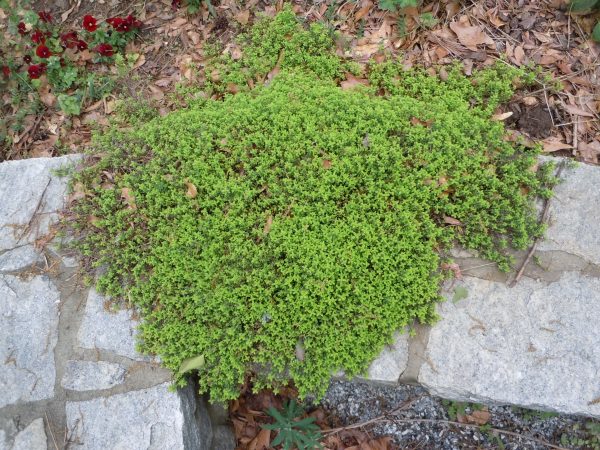Thyme

Thymus vulgaris
taken from The Georgia Fruit and Vegetable Book by Walter Reeves and Felder Rushing
This traditional perennial herb grows as a ground cover up to 12 inches high and spreading many times as wide if it is not contained. Thyme is a popular herb used in many kinds of dishes including salads, stocks, stews, stuffings, vinegars, pork, beef, fish, sausages, vegetables, breads and honey.
• See also Home Garden Thyme
WHEN TO PLANT
Spring is the time to plant Thyme. Use plants that have been grown in containers or divide existing plants. You can also start plants from seed sown indoors under lights. Be aware that named varieties (that is, cultivars, or selections that have been made for quality) are generally superior to seedgrown plants.
WHERE TO PLANT
Plant it in full sun (8 to 10 hours) or partial shade (filtered sun all day or shade part of the day) in welldrained but not overly fertile soil. Thyme grows well in containers and makes an attractive plant for the porch or patio. A single plant of a variety is sufficient for fresh use; you may want to grow several varieties because each variety has a different taste. The plants make attractive edging and more may be used more for that purpose than for harvesting.
HOW TO PLANT
Prepare the soil. Set plants on 12inch centers in rows or in beds. If several varieties are to be planted, separate them with barriers, such as timbers, bricks, or tiles, to prevent them from becoming an indistinguishable, tangled mess.
CARE AND MAINTENANCE
Trim Thyme to keep it in bounds. Thyme may become contaminated by weeds and after a few years the plants decline, becoming messy and woody. Most growers restart their Thyme planting after 3 or 4 years. Take cuttings from old plants and just stick the cuttings in the ground; they root easily. Or divide old plants and replant them in another part of the garden. Excess moisture easily damages Thyme, so water only if rain has not fallen for several weeks. Low fertility results in the best flavor. Vigorously growing plants have much less flavor and spread quickly, taking over the garden. Mites may become troublesome indoors. Spray the plants with insecticidal soap and wash them thoroughly before use.
ADDITIONAL INFORMATION
Harvest Thyme by clipping off 6 to 8inch stems. Use them fresh, or tie the stems in loose bunches to dry quickly on a window screen. Strip leaves from the stems and store the leaves in airtight jars. To have a supply of thyme all winter, lift a few plants before they are frozen in. Trim them to shape and pot them up. Move them into a cool, bright place indoors where they are accessible to the cook. Return them to the garden in spring.
VARIETIES
English Thyme has flat green leaves. French Thyme is known for its superior flavor. ‘Orange Balsam’ has a distinctive citrus fragrance. Lemon Thyme (Thymus citriodorus) is lemony; there are several cultivars of Lemon Thyme.














